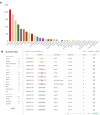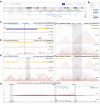EXPRESSO: a multi-omics database to explore multi-layered 3D genomic organization
- PMID: 39498488
- PMCID: PMC11701744
- DOI: 10.1093/nar/gkae999
EXPRESSO: a multi-omics database to explore multi-layered 3D genomic organization
Abstract
The three-dimensional (3D) organization of the human genome plays a crucial role in gene regulation. EXPloration of Regulatory Epigenome with Spatial and Sequence Observations (EXPRESSO) is a novel multi-omics database for exploration and visualization of multi-layered 3D genomic features across 46 different human tissues. Integrating 1360 3D genomic datasets (Hi-C, HiChIP, ChIA-PET) and 842 1D genomic and transcriptomic datasets (ChIP-seq, ATAC-seq, RNA-seq) from the same biosample, EXPRESSO provides a comprehensive resource for studying the interplay between 3D genome architecture and transcription regulation. This database offers diverse 3D genomic feature types (compartments, contact matrix, contact domains, stripes as diagonal lines extending from a genomic locus in contact matrix, chromatin loops, etc.) and user-friendly interface for both data exploration and download. Other key features include REpresentational State Transfer application programming interfaces for programmatic access, advanced visualization tools for 3D genomic features and web-based applications that correlate 3D genomic features with gene expression and epigenomic modifications. By providing extensive datasets and tools, EXPRESSO aims to deepen our understanding of 3D genomic architecture and its implications for human health and disease, serving as a vital resource for the research community. EXPRESSO is freely available at https://expresso.sustech.edu.cn.
Plain language summary
EXPloration of Regulatory Epigenome with Spatial and Sequence Observations (EXPRESSO) is a multi-omics database that provides insights into the three-dimensional (3D) organization of the human genome across 46 different tissues. It integrates over 2200 various genomic and epigenomic datasets to reveal how the 3D genome organization influences gene regulation. Key features include visualization tools to explore 3D genomic features like compartments, domains, stripes and loops, as well as applications to analyze relationships between genome structure and gene expression. It also provides application programming interface for easy data access. EXPRESSO serves as a valuable resource for researchers studying how genome architecture impacts gene regulation in both health and disease.
© The Author(s) 2024. Published by Oxford University Press on behalf of Nucleic Acids Research.
Figures







Similar articles
-
scCancerExplorer: a comprehensive database for interactively exploring single-cell multi-omics data of human pan-cancer.Nucleic Acids Res. 2025 Jan 6;53(D1):D1526-D1535. doi: 10.1093/nar/gkae1100. Nucleic Acids Res. 2025. PMID: 39558175 Free PMC article.
-
WashU Epigenome Browser update 2022.Nucleic Acids Res. 2022 Jul 5;50(W1):W774-W781. doi: 10.1093/nar/gkac238. Nucleic Acids Res. 2022. PMID: 35412637 Free PMC article.
-
PIGOME: An Integrated and Comprehensive Multi-omics Database for Pig Functional Genomics Studies.Genomics Proteomics Bioinformatics. 2025 May 10;23(1):qzaf016. doi: 10.1093/gpbjnl/qzaf016. Genomics Proteomics Bioinformatics. 2025. PMID: 40036767 Free PMC article.
-
Decoding the plant genome: From epigenome to 3D organization.J Genet Genomics. 2020 Aug;47(8):425-435. doi: 10.1016/j.jgg.2020.06.007. Epub 2020 Aug 8. J Genet Genomics. 2020. PMID: 33023833 Review.
-
A review of deep learning models for the prediction of chromatin interactions with DNA and epigenomic profiles.Brief Bioinform. 2024 Nov 22;26(1):bbae651. doi: 10.1093/bib/bbae651. Brief Bioinform. 2024. PMID: 39708837 Free PMC article. Review.
Cited by
-
The 2025 Nucleic Acids Research database issue and the online molecular biology database collection.Nucleic Acids Res. 2025 Jan 6;53(D1):D1-D9. doi: 10.1093/nar/gkae1220. Nucleic Acids Res. 2025. PMID: 39658041 Free PMC article.
References
MeSH terms
Substances
Grants and funding
- K241141101/Natural Science Foundation of China Excellent Young Scientists Fund (Overseas)
- 2024B1515020047/Guangdong Basic and Applied Basic Research Foundation for Distinguished Young Scholars
- JCYJ20230807093514029/Shenzhen Pengcheng Peacock Plan, Shenzhen Basic Research General Projects of Shenzhen Science and Technology Innovation Commission
- 82373932/National Natural Science Foundation of China
- 2208085MH203/Natural Science Foundation of Anhui Province
- YQZD2023023/Department of Education of Anhui Province Outstanding Young Teacher Training Project
- 2022-zhyx-C09/Research Fund of Anhui Institute of Translational Medicine
- 32370630/National Natural Science Foundation of China
- 2021YFC2701201/National Key Research and Development Program of China
- 2023M741534/China Postdoctoral Science Foundation
LinkOut - more resources
Full Text Sources

